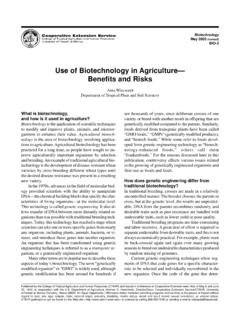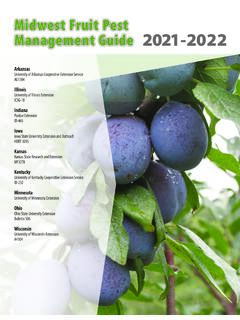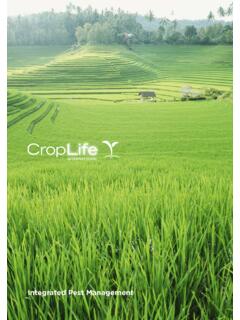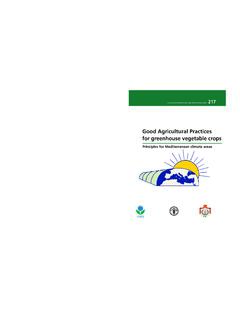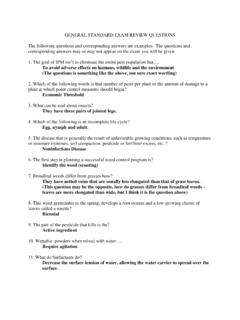Transcription of Biopesticides: An ecofriendly approach for pest control
1 186 Journal of biopesticides 3(1 Special Issue) 186 - 188 (2010) biopesticides : An eco-friendly approach for pest controlBiopesticides: An ecofriendly approach for pest controlSuman Gupta and A. K. Dikshit*ABSTRACTAn ecofriendly alternative to chemical pesticides is biopesticides , which encompasses a broad array of microbial pesticides,biochemicals derived from micro-organisms and other natural sources, and processes involving the genetic incorporationof DNA into agricultural commodities that confer protection against pest damage. biopesticides fall into three majorclasses. The potential benefits to agriculture and public health programmes through the use of biopesticides are interest in biopesticides is based on the disadvantages associated with chemical pesticides are discussed. The totalworld production of biopesticides is over 3,000 tons/yr, which is increasing at a rapid rate.
2 India has a vast potential forbiopesticides. However, its adoption by farmers in India needs education for maximizing gains. The market share ofbiopesticides is only of the total pesticide market. The stress on organic farming and on residue free commoditieswould certainly warrant increased adoption of biopesticides by the farmers. biopesticides being target pest specific arepresumed to be relatively safe to non-target organism including humans. However, in India, the registration committeerequires the data on chemistry, bioefficacy, toxicity and packaging and labeling, for registration. Pesticide RegistrationCommittee has so far not approved any guidelines for the registration of GM biopesticides . In India, some of the biopesticideslike Bt, NPV, neem based pesticides, etc. have already been registered and are being words: biopesticides , IPM, PIPs, Bt, NPV.
3 JBiopest. 125 INTRODUCTIONA griculture has had to face the destructive activities ofnumerous pests like fungi, weeds and insects from timeimmemorial, leading to radical decrease in yields. With theadvent of chemical pesticides, this crisis was resolved to agreat ext ent. But the over dependence on chemicalpesticides and eventual uninhibited use of them hasnecessitated for alternatives mainly for environmentalconcerns. Degraded soils and groundwater pollution hasresulted in nutritionally imbalanced and unproductivelands. Violative pesticide residues also sometimes raisefood safety concerns among domestic consumers and posetrade impediments for export crops. Therefore, an eco-friendly alternative is the need of the hour. Biopesticidesor bi ol ogi ca l p est i ci de s ba se d on pa t h ogen i cm i cr oor ga n i sm s speci fi c t o a t a r get pest offer a necologically sound and effective solution to pest pose less threat to the environment and to humanhealth.
4 The most commonly used biopesticides are livingorganisms, which are pathogenic for the pest of include biofungicides (Trichoderma), bioherbicides(Phytopthora) and bioinsecticides (Bacillus thuringiensis).The potential benefits to agriculture and public healthpr ogr a m m es t h r ough t h e u se of bi opest i ci des a r econsiderable. The interest in biopesticides is based on theadvantages associated with such products which are: (i)inher en tly less harmful and less environmental load,(ii)designed to affect only one specific pest or, in somecases, a few target organisms, (iii)often effective in verysmall quantities and often decompose quickly, therebyresulting in lower exposures and largely avoiding thepollution problems and (iv)when used as a component ofI n t e g r a t e d P es t M a n a g e m en t ( IP M ) pr og r a m s , biopesticides can contribute , biopesticides have the following benefits: FactorsBenefits ofbiopesticidesCost effectiven essCostlier but reducednumber of applicationsPersistence andLow, mostlyresidual effectbiodegradable and selfper petuatingKnockdown effectDelayedHandling and BulkinessBulky.
5 Carrier basedEasy:Liquid formulationPest resurgenceLessResistenceLess proneEffect on beneficial floraLess harmful on beneficialpest sTarget specificityMostly host specificWaiting timeAlmost nilNature of controlPreventiveShelf lifeLessBiopesticides fall into three major categories:(1) Mic robi al pesti cide s conta in a microor gani sm(bacterium, fungus, virus, protozoan or alga) as the active187 Suman Gupta and A. K. Dikshitingredient. Microbial pesticides can control many differentkinds of pests, although each separate active ingredient isrelatively specific for its target pest[s]. For example, thereare fungi that control certain weeds, and other fungi thatkill specific insects. The most widely known microbialpest ici des a re va r i eti es of t he ba ct eri um B ac il l usthuringiensis, or Bt, which can control certain insects incabbage, potatoes, and other crops.
6 Bt produces a proteinthat is harmful to specific insect pests. Certain othermicrobial pesticides act by out-competing pest pesticides need to be continuously monitored toensure they do not become capable of harming non-targetorganisms, including humans.(2) Plant-pesticides are pesticidal substances that plantsproduce from genetic material that has been added to theplant. For example, scientists can take the gene for the Btpesticidal protein, and introduce the gene into the plantsown genetic material. Then the plant, instead of the Btbacterium manufactures the substance that destroys thepest. Both the protein and its genetic material are regulatedby EPA; the plant itself is not regulated.(3) Biochemical pesticides are naturally occurringsubstances that control pests by non-toxic pesticides, by contrast, are synthetic materialsthat usually kill or inactivate the pest.
7 Biochemical pesticidesinclude substances that interfere with growth or mating,such as plant growth regulators, or substances that repelor att ract pests, such as pheromones. Because it issometimes difficult to determine whether a natural pesticidecontrols the pest by a non-toxic mode of action, EPA hasestablished a committee to determine whether a pesticidemeets the criteria for a biochemical pesticide. The growthof total world production of biopesticides is rising andtherefore demand and use is also increasing. In India,biopesticide consumption has shown its incr eased useover the time (Figure 1). In 2005-06, consumption ofbi opesti ci des i n In di a st a n ds a t 1920 MT (h t t p: / ipmpest_ ).0500100015002000 Biopesticide consumption (MT)1994-95 1996-97 1998-99 2000-01 2002-03 2004-05 2005-06 Figure 1.
8 Consumption of biopesticides (MT)India has a vast potential for biopesticides . However, itsadoption by farmers in India needs education for maximizinggains. biopesticides represent only (as on 2005) ofthe overall pesticide market in India and is expected to exhibitan annual growth rate of about in the coming years(Thakore, 2006). In India, so far only 12 types of biopesticides have been registered under the Insecticide Act, 1968(Table 1) ( ).Table 1. biopesticides Registered under Insecticides Act,1968S. of the thuringiensis var. thuringiensis var. thuringiensis var. of Helicoverpa of Spodoptera based biopesticides produced and used in India are brieflydescribed below ( ).NeemDerived from the neem tree (Azadirachta indica), thiscontains several chemicals, including azadirachtin , whichaffects the reproductive and digestive process of a numberof important pests.
9 Recent research carried out in India andabroad has led to the development of effective formulationsof neem, which are being commercially produced. As neemis non-toxic to birds and mammals and is non-carcinogenic,its demand is likely to increase. However, the present demandis very small. Although more than 100 firms are registered toproduce neem-based pesticides in India, only a handful areactually producing it. Furthermore, very little of theproduction is sold locally, most being for export thuringiensis (Bt)Baci ll us t huri ngie nsis i s th e most comm on ly usedbiopesti cide globa lly. It is prima rily a pat hogen oflepidopterous pests like American bollworm in cotton andstem borers in rice. When ingested by pest larvae, Btreleases toxins which damage the mid gut of the pest,eventually killing it. Main sources for the production ofBT pr epar a t ion s ar e t he st ra i n s of th e subspeci eskurstaki, galeriae and are target specific viruses which can infect anddestroy a number of important plant pests.
10 They areparticularly effective against the lepidopterous pests of188 biopesticides : An eco-friendly approach for pest controlcotton, rice and vegetables. Their large-scale productionposes certain difficulties, so their use has been limited tosmall areas. They are not available commercially in India,but are being produced on a small scale by various IPMcentres and state agricultural ma is a fungicide effective against soil borndiseases such as root rot. It is particularly relevant fordryland crops such as groundnut, black gram, green gramand chickpea, which are susceptible to these of Trichoderma biopesticide is cheap andrequires only basic knowledge of are minute wasps which are exclusively egg-parasites. They lay eggs in the eggs of various lepidopteranpests. After hatching, the Trichogramma larvae feed on anddestroy the host egg.
